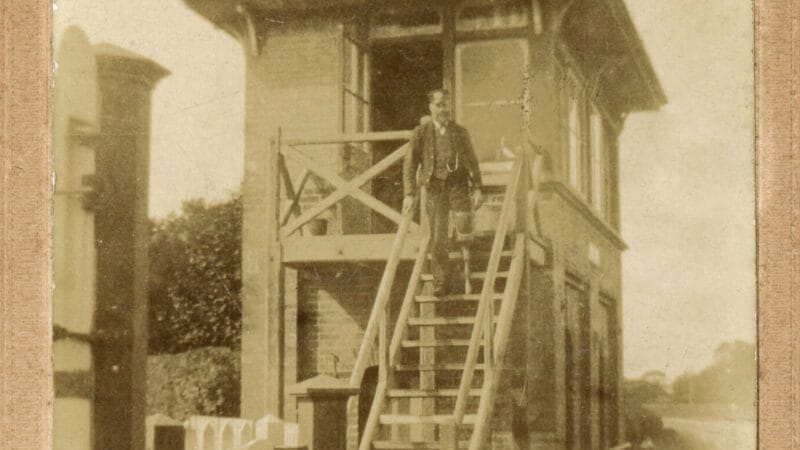Thousands of workers stepping off their morning train has become an enduring image of the railway. But the custom of commuting has constantly evolved, as Christian Wolmar reports.
One of the most remarkable early railways was the London & Greenwich – the capital’s first line completed in 1838, which still bestrides south-east London today. It was a railway before its time – a short suburban commuter line built before there were either suburbs or commuters. But its purpose was clear, as a remarkable pamphlet published in 1833 by the railway company presciently foretold, predicting the development of commuting helped by cheap fares.
The speed with which the inhabitants can be conveyed from the smoke of the city to the pure air of Blackheath and Shooter’s Hill will be a great inducement to the occupation of houses on this side of London.
Thousands of labourers could sleep in cheap lodgings at a distance from town, and yet carry on their daily labour in the metropolis, at a loss of 6d a day.
This ability to live far away from work and to enjoy the more salubrious environment outside the centre of the city would, in fact, become the core reason for building all the suburban lines that would soon be used by millions of commuters.
Construction of the London & Greenwich was all the more astonishing because it was so expensive, completed on 878 arches over land that was too valuable for a railway company to take over. The arches below were supposed to be used for commerce and housing, but they did not attract many tenants.
Although the railway stretched a mere four miles from Greenwich to London Bridge (its initial terminus was at Spa Road, as building that last few hundred yards was expensive and difficult), passenger usage right from the start was intensive.
And there was so much demand from other railways to use these lines that soon the tracks were doubled – and then increased again.
Yet the commuting phenomenon took rather longer to take off.
The amazing viaducts of the world’s first elevated railway had been built with promenades on either side for people who were reluctant to use the trains.
Soon these were taken over for railway use, as the London & Brighton, the London & Croydon and the South Eastern a!J started using the expanded tracks for trains running to and from the capital.
While undoubtedly some of these early passengers were regulars who went to and from their place of work, commuting at this stage was still a rare phenomenon. Trams initially ran every quarter of an hour, with no special provision for rush hours.
Even so, passenger numbers exceeded expectations. By June 1840, 5.7 million people had travelled on the line, making the company highly profitable.
The London & Greenwich was in fact something of an exception among early London railways, in that it was short and served what would later become suburbs of the capital.
By 1854, London’s system comprised a dozen railways, but only the London & Blackwall and the London & Croydon (along with the Greenwich) ran frequent services to local stations. Others simply ignored the outskirts of the capital and the potential to serve their residents.
As the great Jack Simmons puts it in his book on the Victorian Railway; “The trunk lines out of King’s Cross, Euston and Paddington hardly noticed the suburban traveller at all. The railways had in truth hardly begun to find their feet in suburban traffic anywhere in the country.”
Remarkably, despite the railway mania of the 1840, the area encompassed by Greater London only contained 30 miles of railway in 1845 – and just 69 miles 15 years later.
This began to change in the following decade, when three stations were built north of the river, but served largely suburban destinations in the south. Victoria, Charing Cross and Cannon Street were primarily used for short-distance travellers.
By 1880, mileage had increased commensurately to reach 215 miles of track, as it was in the second half of the 19th century that the commuting habit really took off and became the norm for many (mostly male) Londoners.
Belatedly, the railway companies had understood that there was money to be made through providing for suburban travellers. And there were now more of them. London, the largest city in the world, was growing rapidly.
But while there were a few pockets of the city centre that were desirable places in which to live, for the most part London’s traditional areas were overcrowded and insalubrious.
Crucially, too, London’s commercial success was creating new classes of professional people such as lawyers, doctors and bankers, all anxious to find suitable accommodation away from the crowded centre.
They would populate the better suburbs, while the lower classes would be attracted to more modest parts of the ever-expanding capital.
It was the opening of the Metropolitan Railway in 1863 that for the first time enabled many people to live further away from their work, and which consequently stimulated the need to commute.
Indeed, Charles Pearson, the city solicitor who had driven through the project was motivated by a desire to improve the lot of the poor who were forced to live near their work for want of transport.
His idea was that the green fields around London would allow for the construction of far more salubrious housing, with residents then commuting into the centre for work.
The rapid expansion of the Metropolitan and its rival District Metropolitan Railway were testimony to the fact that Pearson had got it right. Soon the strawberry fields of Hammersmith were covered by pleasant, mass-produced housing that filled up rapidly with people who became commuters.
The success or the Metropolitan Railway, and the eagerness or the railway companies to make use of their new terminals, resulted in London experiencing a late railway mania.
As with so much about railway history, it is difficult to disentangle cause and effect. The relationship between railways and urban sprawl is symbiotic – it is impossible to work out whether the growth of the railways was the result or the cause of the development of suburbia.
As London’s workforce grew, the need for commuting increased.
By the 1870s, London had 14 terminus stations. Each had contributed to the need to travel longer distances to work – the land to build them had been cleared of housing, forcing their inhabitants to live further out.
And there was, suddenly, a vast number of new railway bills being presented to Parliament for suburban lines, many of which proved successful.
The railway companies now realised that providing workmen’s trains, offering cheap fares for early morning commuters, was worthwhile business.
The first of these trams ran in the 1860s, but many more began operation after their provision was made mandatory by the government in the 1883 Workmen’s Trams Act.
Interestingly, the number of women commuters also increased in this period, as more and more unmarried girls worked as secretaries or waitresses, rather than going into domestic service. They were for a long time a minority – but a significant one.
As a result of these changes, suburbs grew up around London whose very existence was made possible by the railways.
There was, too, a pattern. Where particularly cheap or early trains were available, houses suitable for the lowest-paid workers were built.
In slightly more affluent areas, where the trains were more expensive, the housing would be more suitable for blue collar (or even white) collar workers.
By the start of the Edwardian era, the ‘rush hour’ and the resultant physical separation of home from work had been established for many of the capital’s workers.
Commuting became the norm, and the system improved between the wars with electrification of most of the Southern Railway’s network, thanks to the efforts of its leader, Sir Herbert Walker.
During this inter-war period, the London Underground spread out further into the suburbs. Extensions linked the central core with villages and small towns that soon, as a result, became incorporated into the capital.
The Metropolitan Railway was the sole fortunate beneficiary of legislation that allowed the railway company to develop land on its path.
Consequently, the area it served north-west of London became known as Metro-land, and it built up rapidly because the company knew it would have a captive market for its trains.
No other railway company was able to benefit in this way from the increase in land values which its services underpinned, which would have allowed further development.
Away from London, commuting networks built up in many large conurbations, although on a far more modest scale than in the capital.
The networks lucky enough to be designated as Public Transport Authorities in Barbara Castle’s ground-breaking Transport Act were able to invest to improve services. But in cities excluded from the act, such as Bristol and Nottingham, many lines closed – largely out or neglect.
Even in London, however, railway commuting has had its ups and downs.
There was a time in the post-war period when the suburban railway was under threat owing to a decline in investment on the railways and the focus on providing for car-based commuters with urban highways and motorways.
Remarkably, for example, the North London Railway, a vital link between east and west London serving many suburban communities, was actually earmarked for closure in the 1980s.
Underground stations were also slated for closure, and there were plans for massive ring roads to cater for the ever-growing numbers or people commuting into town by car.
Meanwhile the tram system, a great adjunct to the railways, was scrapped in the 1950s as they were deemed to get in the way of cars.
However, it soon dawned on politicians that this was unsustainable. Much of London would have had to be demolished lo make way for the ring roads, and parking was becoming an insuperable difficulty.
The idea that cars could become the mainstay of commuting was thus abandoned – and the plans for ring roads were scrapped in the 1980s.
Symbolically, Horse Guards Parade, used by civil servants driving into work, was cleared of parked cars in 1997. People had to take to the trains and buses.
With the boom in office building stimulated by the 1986 Big Bang, deregulation of financial services, and the development of Canary Wharf (which soon was served by the Jubilee Line as well as the Docklands Light Railway and lately by the Elizabeth line), commuting was back in fashion.
Until COVID hit. The drop was extraordinary and instant. With the government telling people not to travel, but with the trains still forced to operate for key workers, revenue from fares dropped from £8 billion to just £1.5bn between 2019-20 and 2020-21, and season ticket sales fell from more than £2bn to just £333 million.
And while overall ticket sales have almost recovered to their pre-COVID levels, season tickets are still at under half their previous level.
But while the decline in season ticket sales as a proportion of fares income has continued, commuting has by no means died.
Instead, people are working more flexibly. Therefore, a monthly or annual season ticket is not worthwhile.
However, working from home permanently is increasingly being frowned upon by employers, and therefore people are coming to work two or three days per week.
The one major change is that Thursday, with peak hours still crowded, is now the new Friday, which in turn has seen a decline in rail travel. These trends still have to play out, as they remain affect by the COVID period.
The advent or new technology which enables people to work from home and travel into their offices at different times has changed the world or commuting forever.
Nevertheless, the success of the Elizabeth line, which links great swathes of east and west London with the City, West End and Canary Wharf demonstrates that the demand is still there. House prices have been boosted along its route, demonstrating that people value this rapid way into the centre or London.
Commuting will remain a key part of the rail industry’s patronage, but the pattern of use has changed.
Paradoxically, this could be helpful for the rail companies who struggled with the financial burden or providing train sets that would be used just twice a day.
However, they have so far been slow to adapt to these new patterns of demand, and making the right adaptations will be a challenge for the new Great British Railway.


